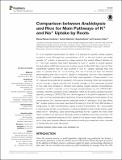Por favor, use este identificador para citar o enlazar a este item:
http://hdl.handle.net/10261/152989COMPARTIR / EXPORTAR:
 SHARE SHARE
 CORE
BASE CORE
BASE
|
|
| Visualizar otros formatos: MARC | Dublin Core | RDF | ORE | MODS | METS | DIDL | DATACITE | |

| Título: | Comparison between Arabidopsis and Rice for Main Pathways of K+ and Na+ Uptake by Roots |
Autor: | Nieves-Cordones, Manuel CSIC ORCID ; Martínez, Vicente CSIC ORCID; Benito, Begoña CSIC ORCID; Rubio, Francisco CSIC ORCID | Fecha de publicación: | 5-jul-2016 | Editor: | Frontiers Media | Citación: | Frontiers in Plant Science 7: 992 (2016) | Resumen: | K+ is an essential macronutrient for plants. It is acquired by specific uptake systems located in roots. Although the concentrations of K+ in the soil solution are widely variable, K+ nutrition is secured by uptake systems that exhibit different affinities for K+. Two main systems have been described for root K+ uptake in several species: the high-affinity HAK5-like transporter and the inward-rectifier AKT1-like channel. Other unidentified systems may be also involved in root K+ uptake, although they only seem to operate when K+ is not limiting. The use of knock-out lines has allowed demonstrating their role in root K+ uptake in Arabidopsis and rice. Plant adaptation to the different K+ supplies relies on the finely tuned regulation of these systems. Low K+-induced transcriptional up-regulation of the genes encoding HAK5-like transporters occurs through a signal cascade that includes changes in the membrane potential of root cells and increases in ethylene and reactive oxygen species concentrations. Activation of AKT1 channels occurs through phosphorylation by the CIPK23/CBL1 complex. Recently, activation of the Arabidopsis HAK5 by the same complex has been reported, pointing to CIPK23/CBL as a central regulator of the plant’s adaptation to low K+. Na+ is not an essential plant nutrient but it may be beneficial for some plants. At low concentrations, Na+ improves growth, especially under K+ deficiency. Thus, high-affinity Na+ uptake systems have been described that belong to the HKT and HAK families of transporters. At high concentrations, typical of saline environments, Na+ accumulates in plant tissues at high concentrations, producing alterations that include toxicity, water deficit and K+ deficiency. Data concerning pathways for Na+ uptake into roots under saline conditions are still scarce, although several possibilities have been proposed. The apoplast is a significant pathway for Na+ uptake in rice grown under salinity conditions, but in other plant species different mechanisms involving non-selective cation channels or transporters are under discussion. | Versión del editor: | http://dx.doi.org/10.3389/fpls.2016.00992 | URI: | http://hdl.handle.net/10261/152989 | DOI: | 10.3389/fpls.2016.00992 | ISSN: | 1664-462X |
| Aparece en las colecciones: | (CEBAS) Artículos |
Ficheros en este ítem:
| Fichero | Descripción | Tamaño | Formato | |
|---|---|---|---|---|
| Comparison between Arabidopsis and Rice.pdf | 590,72 kB | Adobe PDF |  Visualizar/Abrir |
CORE Recommender
PubMed Central
Citations
34
checked on 23-abr-2024
SCOPUSTM
Citations
101
checked on 19-abr-2024
WEB OF SCIENCETM
Citations
85
checked on 28-feb-2024
Page view(s)
273
checked on 23-abr-2024
Download(s)
373
checked on 23-abr-2024

